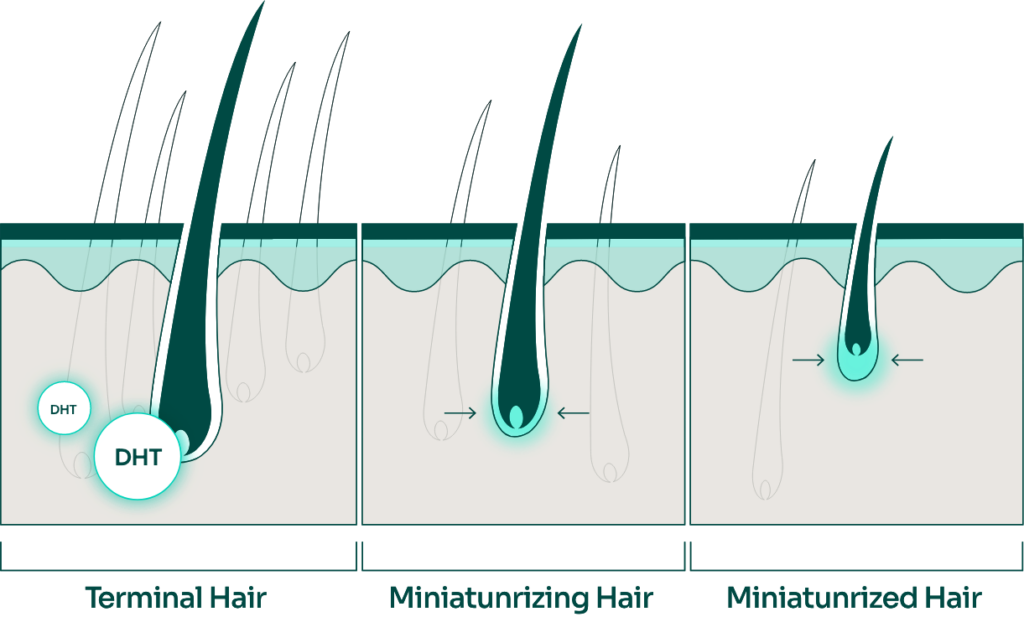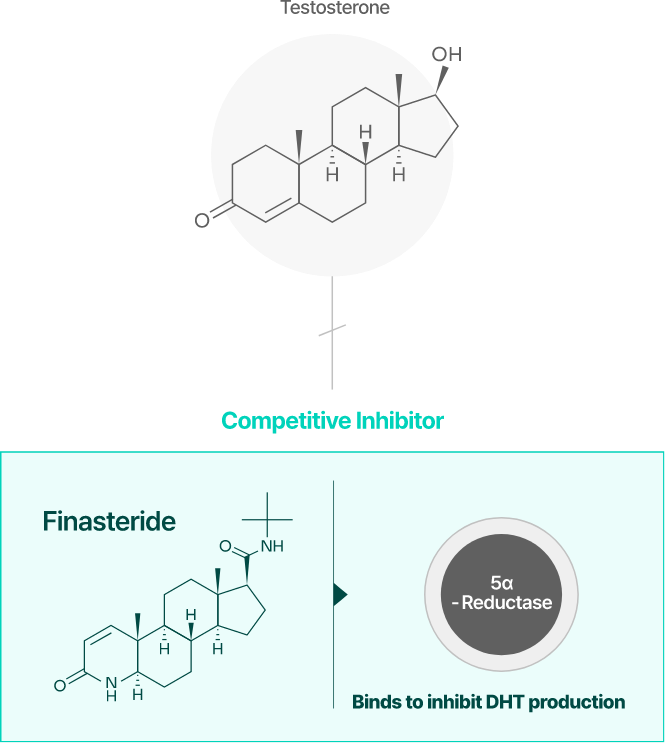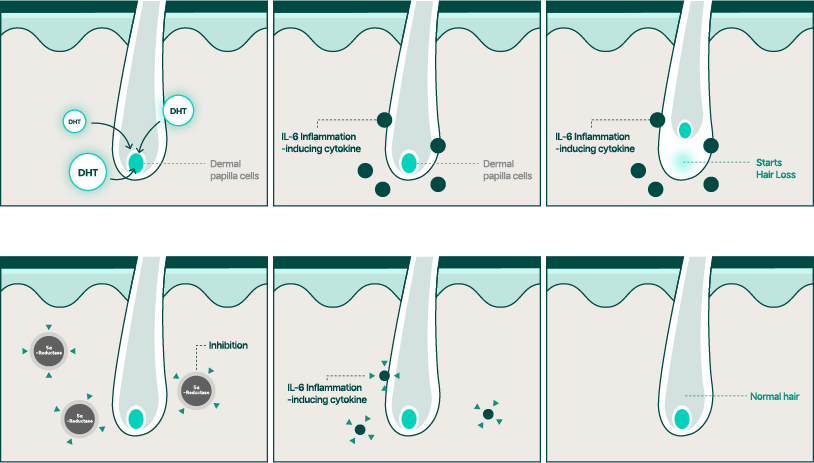We have a more advanced scientific perspective
on the causes of hair loss.
Let’s examine the perspective of BensLab Research Institute on why the increase in
Dihydrotestosterone (DHT), a derivative of the male hormone often cited as a cause of androgenetic
alopecia, leads to hair loss.
We have a more advanced scientific perspective on the causes of hair loss
Let’s examine the perspective of BensLab Research Institute on why the increase in Dihydrotestosterone (DHT), a derivative of the male hormone often cited as a cause of androgenetic alopecia, leads to hair loss.
Cause of Androgenic Alopecia and Finasteride
It is known that androgenetic alopecia occurs when the male hormone testosterone is converted into Dihydrotestosterone (DHT) by 5-alpha-reductase,
leading to the accumulation of DHT around the hair follicles. This causes the shrinking of hair follicles and a shortened lifespan of hair follicles, resulting in hair loss.

Cause of Androgenic Alopecia and Finasteride
It is known that androgenetic alopecia occurs when the male hormone testosterone is converted into Dihydrotestosterone (DHT) by 5-alpha-reductase, leading to the accumulation of DHT around the hair follicles. This causes the shrinking of hair follicles and a shortened lifespan of hair follicles, resulting in hair loss.

“This became known when it was discovered that a significant amount of DHT accumulates around
hair follicles where hair loss occurs. However, the exact mechanisms of how DHT causes the follicles
to shrink, makes the hair thinner, and eventually leads to hair shedding have not been conclusively elucidated.”
“This became known when it was discovered that a significant amount of DHT accumulates around hair follicles where hair loss occurs. However, the exact mechanisms of how DHT causes the follicles to shrink, makes the hair thinner, and eventually leads to hair shedding have not been conclusively elucidated.”
“This became known when it was discovered that a significant amount of DHT accumulates around hair follicles where hair loss occurs. However, the exact mechanisms of how DHT causes the follicles to shrink, makes the hair thinner, and eventually leads to hair shedding have not been conclusively elucidated.”

Until now, oral medications have primarily focused on reducing the production of DHT. Medications in the Finasteride category, having a molecular structure similar to testosterone, function by binding to the 5-alpha reductase enzyme in lieu of testosterone. This action effectively intercepts the 5-alpha reductase enzyme and prevents the creation of DHT
▶ “This is called a ‘competitive inhibitor’.”

Until now, oral medications have primarily focused on reducing the production of DHT. Medications in the Finasteride category, having a molecular structure similar to testosterone, function by binding to the 5-alpha reductase enzyme in lieu of testosterone. This action effectively intercepts the 5-alpha reductase enzyme and prevents the creation of DHT
▶ “This is called a ‘competitive inhibitor’.”

Until now, oral medications have primarily focused on reducing the production of DHT. Medications in the Finasteride category, having a molecular structure similar to testosterone, function by binding to the 5-alpha reductase enzyme in lieu of testosterone. This action effectively intercepts the 5-alpha reductase enzyme and prevents the creation of DHT
▶ “This is called a ‘competitive inhibitor’.”
BensLab's Perspective
- Inflammation is the primary cause of hair loss
- Hormonal activities should not be directly influenced.
- Exploring solutions from natural plant-based ingredients.
- Inflammation is the primary cause of hair loss.
15 years ago, when BensLab began to find functional ingredients for hair loss, the focus was on developing substances that could inhibit the conversion of testosterone into DHT. After numerous trials and errors, we began to research focusing on the fundamental question of why DHT causes hair loss.
Through this process, we obtained experimental results showing that DHT increases the inflammatory substance IL-6 in hair follicle cells on the scalp, which eventually leads to hair loss. In addition, we also identified other pathways that contribute to the weakening of hair follicles. Based on these findings, we arrived at the idea that inhibiting the production of IL-6 or the 5-alpha-reductase enzyme could potentially prevent hair loss.

- Inflammation is the primary cause of hair loss.
15 years ago, when BensLab began to find functional ingredients for hair loss, the focus was on developing substances that could inhibit the conversion of testosterone into DHT. After numerous trials and errors, we began to research focusing on the fundamental question of why DHT causes hair loss.
Through this process, we obtained experimental results showing that DHT increases the inflammatory substance IL-6 in hair follicle cells on the scalp, which eventually leads to hair loss. In addition, we also identified other pathways that contribute to the weakening of hair follicles. Based on these findings, we arrived at the idea that inhibiting the production of IL-6 or the 5-alpha-reductase enzyme could potentially prevent hair loss.

- Hormonal activities should not be directly influenced.
- Hormonal activities should not be directly influenced.
DHT reduction is effective for hair loss prevention, but it can lead to sexual side effects when reduced excessively. We sought substances that could lower the overproduction of 5-alpha reductase, an enzyme that converts testosterone to DHT. This approach aimed to minimize side effects by maintaining normal 5-alpha reductase levels, preventing DHT overproduction.
We explored a variety of natural plant resources with a focus on reducing the inflammatory substance IL-6, independent of the hormonal conversion process where testosterone is converted to DHT. Additionally, DHT directly stimulates IL-6 production, so it is important to find substances that can reduce DHT. As a result, BensLab focused on discovering substances that could inhibit the activity of 5-alpha reductase, which is responsible for converting testosterone to DHT.”
DHT reduction is effective for hair loss prevention, but it can lead to sexual side effects when reduced excessively. We sought substances that could lower the overproduction of 5-alpha reductase, an enzyme that converts testosterone to DHT. This approach aimed to minimize side effects by maintaining normal 5-alpha reductase levels, preventing DHT overproduction.
- Exploring solutions from natural plant-based ingredients.
- Exploring solutions from natural plant-based ingredients.
BensLab’s extensive research and experience in studying natural compounds have significantly benefited the search for ingredients that counteract hair loss mechanisms. Ingredients derived from natural food sources generally pose fewer side effects in the human body and carry minimal risks compared to chemically altered substances. Given these attributes, health functional food and medications developed from natural compounds can be deemed relatively safer.
BensLab’s extensive research and experience in studying natural compounds have significantly benefited the search for ingredients that counteract hair loss mechanisms. Ingredients derived from natural food sources generally pose fewer side effects in the human body and carry minimal risks compared to chemically altered substances. Given these attributes, health functional food and medications developed from natural compounds can be deemed relatively safer.
However, the most important thing is efficiacy.
Discovering plant ingredients containing active ingredients is not an accidental discovery.
The strength of BensLab lies in its ability to rapidly and scientifically identify these ingredients by utilizing a research database accumulated over many years.
However, the most important thing is efficiacy.
Discovering plant ingredients containing active ingredients is not an accidental discovery.
The strength of BensLab lies in its ability to rapidly and scientifically identify these ingredients by utilizing a research database accumulated over many years.
However, the most important thing is efficiacy.
Discovering plant ingredients containing active ingredients is not an accidental discovery.
The strength of BensLab lies in its ability to rapidly and scientifically identify these ingredients by utilizing a research database accumulated over many years.











